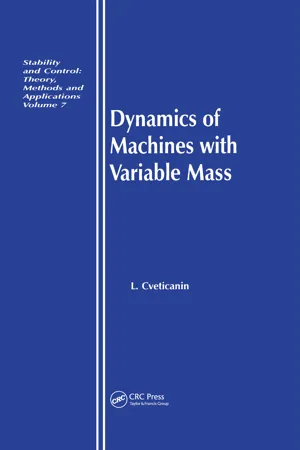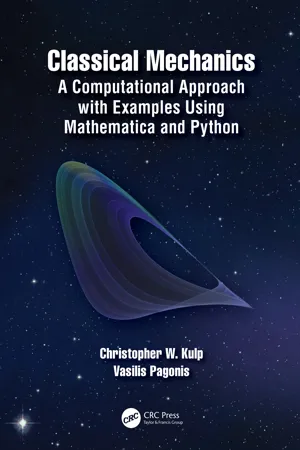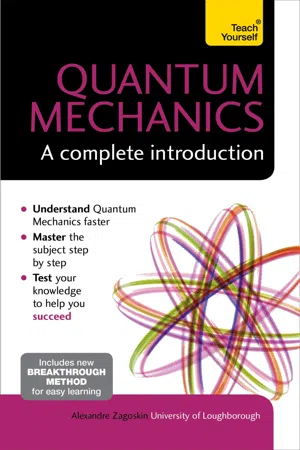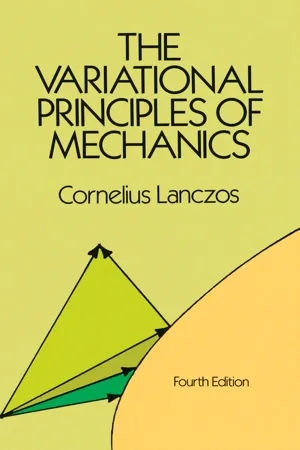Physics
Generalized Momenta
Generalized momenta in physics refer to a concept used in classical mechanics and quantum mechanics to describe the momentum of a system. Unlike regular momentum, generalized momenta can account for systems with varying degrees of freedom and non-conservative forces. In classical mechanics, generalized momenta are used in Hamiltonian mechanics, while in quantum mechanics, they are essential for describing the behavior of particles.
Written by Perlego with AI-assistance
Related key terms
Related key terms
1 of 4
Related key terms
1 of 3
5 Key excerpts on "Generalized Momenta"
- eBook - ePub
- L Cveticanin(Author)
- 2022(Publication Date)
- Routledge(Publisher)
2 General Priniciples of Dynamics of Systems with Variable Mass2.0 Introduction
In this chapter, which has four sections, the general principles of dynamics of systems with variable mass are considered. The first section deals with the dynamics of a single particle with variable mass, and the second of a system of particles with variable mass. The principles of momentum and angular momentum and the energy principle are considered for variable mass systems. In the third section the dynamics of bodies with variable mass are analyzed. Differential equations for rigid bodies with variable mass are formed. Lagrange’s differential equations are adopted for systems with variable mass. Using the theoretical results from the previous sections, in the fourth section mathematical models of motion of a special group of mechanisms are obtained. The differential equations are derived of motion of vibrations of one-degree-of-freedom mechanisms with variable mass, of a symmetrical rotor with band winding, and of a clamped free rotor with variable mass.2.1 Dynamics of Particles with Variable Mass
The derivation of equations of motion for systems with variable mass is connected with difficulties which come from the fact that the basic principles of classical dynamics (Newton-Euler equations, Lagrange’s equations, etc) are only valid for systems comprising definite sets of objects with constant masses. Yet, if attention is to be restricted to B in Fig. 2.1.1 , as practical considerations demand, then the equations of motion cannot be obtained by direct application of any of formulations of classical dynamics described above, because the mass of B varies with time.FIGURE 2.1.1 Model of variable mass system.To circumvent this difficulty, a different strategy was developed. The system at any given instant consists of three parts, B, B’ and B" (see Fig. 2.1.1 ). Here B is the main part of the system, B" represents the part of B that will be lost at a later time, and ’ is material that will coalesce with B - eBook - ePub
- Robert Weinstock(Author)
- 2012(Publication Date)
- Dover Publications(Publisher)
8 ).Application of Lagrange’s equations to specific mechanical systems is found in the exercises at the end of this chapter.(c ) Since the lagrangian L does not explicitly involve the time variable t , the equations of motion (8 ) lead, according to (59 ) of 3-8(b ), to the first integralwhere E is a constant. To interpret (9 ) we note first that , so that, according to (6 ) of 6-l(d ), for all i = 1, 2, …, N . Since, according to 6-l(d ), T is a homogeneous function, of degree two, of , we therefore have from Euler’s theorem (2-5) that . Thus, with (6 ), equation (9 ) becomes 2T – (T – V ) = E , orThat is, the motion of a conservative system is characterized by the constancy of the sum of the potential and kinetic energies (whence the appellation conservative). The constant E , the total energy of the system, is determined when the initial values of all the6-3. Generalized Momenta. Hamilton Equations of Motionqiand are assigned.(a ) Dealing with a system whose position configuration is completely described by the generalized coordinates q 1 , q 2 , …,qNand whose lagrangian is L , we define the set p 1 , p 2 , …,pNof Generalized Momenta asSince, according to 6-1(d ), the kinetic energy T is a quadratic form in the generalized velocity components , it follows from the definition (11 ) that eachpiis a linear homogeneous function of . Conversely, solution of the N equations (11 ) must yield each of the as a linear homogeneous function3 of p 1 , p 2 , …,pN - eBook - ePub
Classical Mechanics
A Computational Approach with Examples Using Mathematica and Python
- Christopher W. Kulp, Vasilis Pagonis(Authors)
- 2020(Publication Date)
- CRC Press(Publisher)
Chapter 3 that it is sometimes useful to describe a system using coordinates other than Cartesian coordinates. One challenge of using non-Cartesian coordinates with Newton’s second law is that one has to find the acceleration in the new coordinate system. The new form of the acceleration is often mathematically more complicated than in Cartesian coordinates. The result is that the form of Newton’s second law heavily depends on the coordinate system used. Because the Euler-Lagrange equations take the same form for every coordinate system, it is not necessarily more difficult to work with non-Cartesian coordinate systems when using the Lagrangian.We will use the term generalized coordinates in order to describe any coordinate system that completely specifies the state of the system. Spherical and plane-polar coordinates are examples of generalized coordinate systems, however, generalized coordinates can take many forms. You may find it useful to work with generalized coordinates which have dimensions of energy, angular momentum, or no dimension at all. It is customary to write generalized coordinates as (q1 , , q2 , …) or just as qj(with j = 1, 2, … implied but not always stated).How many generalized coordinates do we need to completely describe the state of a system? This is an important question because it will determine the number of Euler-Lagrange equations we need in order to solve for a system’s behavior. Let’s consider a system of N particles. In order to describe each particle, we will need N vectors of the formr = x, which has three quantities each, x, y, and z. Hence, we will need 3N quantities to describe the position of each particle and, therefore, the state of the system. Next, suppose that there are constraints on the particle’s motion. Each constraint will relate one quantity to another. For example, each particle may be constrained to move on the xy-plane. Regardless of their specific nature, constraints can relate two or more of the quantities to each other or they can impose a value for on particular coordinage (e.g. z = 0). In other words, not all 3N quantities are necessarily independent. If there are m equations of constraint, then there are s = 3N − m degrees of freedom for the system. The number of degrees of freedom is the number of independent quantities that are needed to specify the state of the system. In other words, we will need s independent generalized coordinates in order to describe the state of the system. As we will see, the Euler-Lagrange equations will produce s second order differential equations which, when solved, will give qi ^+ yj ^+ zk ^j(t) for j = 1, 2, …, s - Alexandre Zagoskin(Author)
- 2015(Publication Date)
- Teach Yourself(Publisher)
. Moreover, he proved that these equations are equivalent to those following directly from Newton’s second law, even though the former are much easier to write down than the latter.As before, we can take the set of all generalized coordinates and consider them as the coordinates of a single point in an M-dimensional configuration space. And, as before, we can introduce the phase space (which will be, of course, 2M-dimensional), the state vector in this space, and the Hamilton’s equations. That is, Hamilton did it. In particular, he discovered how – starting from a Lagrangian – one can find the momentum pi , corresponding to a given generalized coordinate qi . It is called the canonical momentum and is often something very unlike . Then he showed how to obtain from the Lagrangian the Hamiltonian H(q,p). And then one can immediately write down and – with some luck and much hard work – solve the Hamilton’s equations and find the behaviour of the system:In many cases these equations are easier to solve than the Lagrange equations. What is more important to us is that they form a vital link between quantum and classical mechanics.Hamilton’s equations describe the evolution with time of the state vector in a 2M-dimensional phase space of our system. One cannot easily imagine this, but some geometrical intuition based on our lower-dimensional experience can be actually developed with practice. For example, you can draw the phase trajectories in each of the M planes (qi ,pi- eBook - ePub
- Cornelius Lanczos(Author)
- 2012(Publication Date)
- Dover Publications(Publisher)
2 for a single particle, and asfor a system of particles; v is here the velocity of the particle, defined byThus the kinetic energy of a particle involves explicitly the line element and hence depends on the geometry of space.Now let us define the line element of a 3N-dimensionaI space by the equationIf we do that, then the total kinetic energy of the mechanical system may be written in the form withThe meaning of this result is that the kinetic energy of the whole system may be replaced by the kinetic energy of one single particle of mass 1. This imaginary particle is a point of that 3N-dimensional configuration space which symbolizes the position of the mechanical system. In this space one point is sufficient to represent the mechanical system, and hence we can carry over the mechanics of a free particle to any mechanical system if we place that particle in a space of the proper number of dimensions and proper geometry.The form (15.11 ) of the line element shows that the 3N-dimensional configuration space of N free particles has a Euclidean structure, and that the quantitieshave to be considered as rectangular coordinates of that space. If the rectangular coordinates (15.14 ) are changed to arbitrary curvilinear coordinates according to the transformation equations (12.4 ), the geometry remains Euclidean, although the line element is now given by the m re general Riemannian form (15.7 ) (with n = 3N).But let us now consider a mechanical system with given kinematical conditions between the coordinates. We can handle such a system in two different ways. We may consider once more the previous configuration space of 3N
Index pages curate the most relevant extracts from our library of academic textbooks. They’ve been created using an in-house natural language model (NLM), each adding context and meaning to key research topics.
Explore more topic indexes
Explore more topic indexes
1 of 6
Explore more topic indexes
1 of 4




